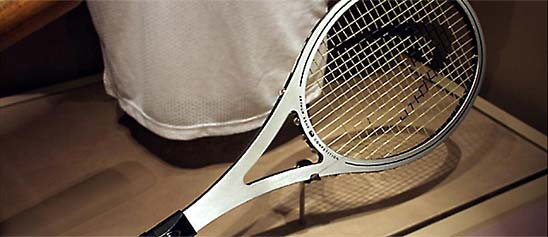This Pontiac No. 43 — that number was Richard Petty's hallmark, as No. 42 was for his father's cars — follows the 1984 design rules. Note the tubular space-frame, specially built body, racing wheels and tires, and safety gear in the interior.
- Description
-
This Pontiac No. 43 — that number was Richard Petty's hallmark, as No. 42 was for his father's cars — follows the 1984 design rules. Note the tubular space-frame, specially built body, racing wheels and tires, and safety gear in the interior. Like current NASCAR racers, its engine is not fuel-injected but uses carburetion. The car carried Petty to victory in the "Firecracker 400" race at Daytona, on July 4, 1984. The car ran one more race that year, the Talledega 500 on July 29th, but did not finish, retiring with a broken differential immediately after its first pit stop. The car owner was Curb Motorsports, owned by Mike Curb, of the family owning Canon Mills and president of Curb Records. The car was repainted by the crew of Petty Enterprises, Randleman, before presentation to the Smithsonian in late 1984. The car is configured for the last time it ran, at the 1984 Talledega race, and has that engine installed. The tires, however, are Daytona tires.
-
A uniquely American type of auto racing is "stock car" racing. Bill France, of Daytona Beach, Florida, had witnessed the popularity of pre-war "beach racing." In the late 1940s, he organized beach races for car-owners who liked the idea of competing against each other with more-or-less "stock" automobiles. To help him set rules for stock-car racing, France created the National Association for Stock Car Auto Racing, NASCAR, in 1948. In 1953, France opened a new Daytona Speedway. NASCAR came of age in 1959, with the first running of the Daytona 500 - which was won by Lee Petty, Richard Petty's father, a three-time NASCAR national champion in his own right, during the 1950s.
-
Richard Petty, of Randleman, NC, began his racing in the early 1960s, winning his first Daytona 500 and first of seven NASCAR national championships in 1964. NASCAR racing in the 1960s consisted of many more top-rank (i.e., Grand National, Winston Cup, and now renamed Nextel Cup) races per year than today. The norm in the 1960s was some 50 or more such races a year. In 1967, Richard Petty won 27 of these (out of 48 races, which included winning 10-straight) to set an all-time record for the most victories in a season. Over his 35-year career, his record of 200 Grand National/Winston Cup racing wins is very likely never to be equaled. (In comparison, the driver with the second-highest total of wins in NASCAR races is David Pearson, with 105 over a 26-year career.)
-
By the 1980s, NASCAR race-car design rules had changed radically since NASCAR's first season in 1949. That year, NASCAR's series ran under "strictly stock" rules. Cars were - or were supposed to be - unaltered from production cars. But that idea ran counter to the decades-long "tradition" among auto racers of cheating under the hood and in the chassis, i.e., adding hidden changes to the engine and suspension to make the car a better performer. Bill France decided to allow certain modifications to both a car's stock engine and its chassis, and to enforce strict discipline against cheating by employing - to look over each car and its engine in detail before each race - a bevy of inspectors answerable to France. The race series was renamed the Grand National series in 1950, and occasional cheating was not, of course, entirely eliminated. Over the years, more and more departures from "stock" components were permitted by the frequently evolving rule changes - the objective of the rule changes, nearly every time, was to let the cars average faster speeds (which brought in more fans), while at the same time trying to eliminate unfair advantages among the cars (close racing, being more exciting, pleased the fans; a race season dominated by just a few drivers that could "run away from the field" in almost every race decreased both fan interest and the interest of other race-car owners to enter their cars).
-
By the 1980s, NASCAR race cars were no longer "stock" at all, being entirely purpose-built, with non-stock tubular space-frames eliminating the stock frame, specially designed springing, 700-horsepower engines in which only the stripped, basic block was "stock," and — significantly — added safety and fire-suppression equipment.
-
Only the basic shape of the hand-made body had to follow the lines of the stock model being represented. "Spoilers" - the lateral flap added to the rear of the "trunk" - used wind to keep the rear of the car down at high speed; headlights became decals; doors didn't exist (the driver climbed-in through the left-hand window opening). Today's NASCAR race cars have even dispensed with following a production car's body lines; the smoothly shaped front-ends of the race cars are designed to reduce wind resistance to a practical minimum. The NASCAR race-car design rules rigidly enforced today are, by far, the most complex of any motorsport; these rules are designed to equalize the cars as much as possible, to provide close, competitive racing.
- Location
-
Currently on loan
- Date made
-
1984
- user
-
Petty, Richard
- maker
-
Petty Enterprises
- ID Number
-
1985.0009.01
- accession number
-
1985.0009
- catalog number
-
1985.0009.01
